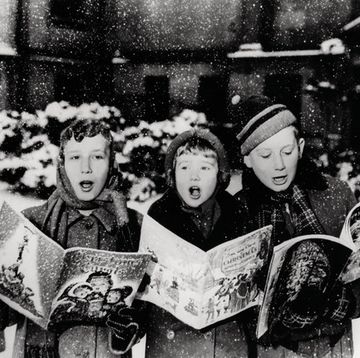Christmas is a time of joy, of beautifully trimmed trees, stockings hung by the chimney with care, and fellowship with family and friends over delish dishes like roasted turkey. It's a time for Santa Claus, too, the chubby fellow in the red suit who arrives on Christmas Eve in a sleigh pulled by flying reindeer. He comes down the chimney, bringing with him not only presents for all the good little boys and girls, but also the magic of the season. That's part of what makes it so difficult for parents when children begin questioning whether Ol' St. Nick is a real person—you don't want to spoil the holiday for them.
And then there is the inevitable feeling that your littles are growing up too fast. Like beginning grade school, asking for the truth about Santa is often one of the big signs they're leaving early childhood and the world of make believe behind. But the fact remains: once your children begin asking "Is Santa real?" you're going to have to spill the beans eventually. Here's how to tell kids the truth about the North Pole's most famous resident.
When to Tell Your Kids About Santa Claus
Experts say you can expect your kids to start wondering about some of Santa's more fantastical elements as young as age seven. They'll start querying you about how Santa can deliver all those presents in a single night or why he uses a sleigh and reindeer instead of an airplane. And how does he fit down the chimney, or, for that matter, what does he do when a house doesn't have a chimney? And then you'll have to make the difficult decision: do you give them the scoop, or let the magic live on for another month, or year, or more?
Since they're asking you about Santa you might want to delay the big talk because they may not be ready to let him go. You can always deflect their questions with some of your own, like "Hmmm...what do you think?" or "Why do you ask that?" But understand that the moment is coming—and it might be coming quickly—when your child will both need and want to hear the truth. Start to plan out now exactly how to respond to them.
However, if they have skipped the questioning phase entirely and are telling you Santa is fictitious—say, if some friends at school they trust have let the reindeer out the bag—you're going to want to respond with honesty. When a child demands, "I know Santa isn't real," don't attempt to keep the charade going. Instead, come clean and let them know Dad's the one who has been consuming the cookies and milk all these years, and you've been responsible for wrapping the presents and putting them under the tree.
But what about those outliers who, against all odds, keeping believing in Santa Claus? You don't want to tell them about Santa earlier than necessary, but then again who wants their child to be teased by other kids for believing in a fairy tale no one else their age does? While everyone is different, according to a recent poll by House Method, the average age kids in the United States stop believing in Santa Claus is 8.5 years. So, chances are good that somewhere around then is the right age for your child to learn the true story about Santa Claus.
What to Tell Your Kids About Santa Claus
So, you know when, approximately, you're going to need to tell your kids about Mr. Claus. But what, exactly, are you going to tell them? How do you keep the spirit of Christmas alive when you've just (let's be honest) debunked its biggest secular symbol? Maybe—depending, of course, on what your family's beliefs and values are—you explain that the magic of Christmas is bigger than just Santa. That he represents kindness and giving, and that magic will never fade, as long as your child keeps it alive in his heart. This could be the perfect time to start a new holiday tradition with them, like secretly giving gifts to those in need, or helping out in a food pantry for a few hours. That way, instead of merely losing their old concept of Santa, they are gaining a new meaningful Christmas activity.
Perhaps you might even want to follow the steps laid out in a social media post that has been going viral at holiday time for years. While the idea isn't a new one, it's pretty perfect. According to USA Today, the original story, which dates back to the Great Depression, involves a resourceful mom and her seven-year-old son, who has started questioning whether Santa exists. Rather than simply informing him that Kris Kringle is an invention, the mom instead sits her son down and tells him he is maturing into a fine young man, giving examples of the ways he has recently acted with empathy.
It's then that she carefully notes that there are two kinds of people in the world: those who believe in Santa, and those who are Santa. And because her child has evolved into such a caring, compassionate person, he is ready to become the latter. To do so, the mother goes on to tell her son, he must pick out a person in need and deliver a present to them anonymously. Most crucially, they cannot know the gift came from him. Because, the mom makes clear in the post, being Santa is not about getting credit for doing good. It's about giving unselfishly.
Brilliant, eh? Instead of taking away the magic of Christmas and telling kids they've been fibbed to in one fell swoop, you are able to let them down much more gently. They are offered not only an engaging new holiday tradition that helps others, but also a lesson in kindness, generosity and goodwill. And after all, isn't the season of giving about those very qualities?
Jill Gleeson is a travel journalist and memoirist based in the Appalachian Mountains of western Pennsylvania who has written for websites and publications including Good Housekeeping, Woman’s Day, Country Living, Washingtonian, Gothamist, Canadian Traveller, and EDGE Media Network. Jill is the travel editor for Enchanted Living. Learn more about her journey at gleesonreboots.com.












